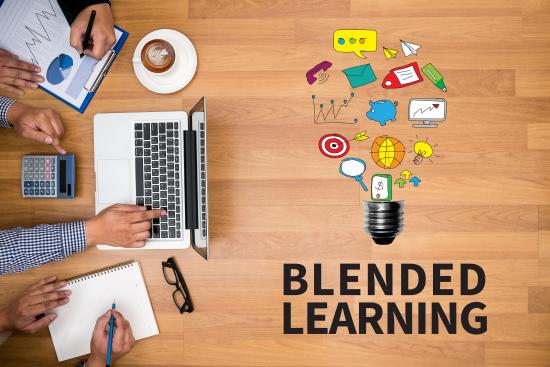The term “blended learning,” sometimes known as “hybrid learning,” “flipped classroom,” or “mixed learning,” refers to a method that combines instructor-led classroom instruction with the online training material, typically in the form of on-demand lectures that learners watch outside of class.
Blended learning has developed into an effective, sustainable, and beneficial way to learn that many firms have started employing, thanks to the advancement of digital education technologies, including videoconferencing, eBooks, simulation models, movies, games, and more.
Let’s see what makes the blended method a sustainable form of learning and training.
Blended learning uses multiple modalities, dramatically reinforcing learning, engagement, and retention.
Combining diverse activities with more passive study improves learning for the majority of people. Blended learning helps to fill in any gaps in knowledge left by modes that weren’t the best for the particular topic or learner. It does that by using as many learning delivery methods as possible. For instance, blended learning promotes a combination of live instructor, video, social, and practical aspects of learning. These could include threaded discussions, video conferences, and internal social media platforms that can all be used to exchange and compare knowledge and show how well newly acquired abilities are applied in the workplace.
It caters to the different learning needs and requirements of the people
It seems impossible to look after the learning needs of all the employees. But not with blended learning. Blended learning can be all the more beneficial when instructing a sizable group of individuals. It helps you diversify your teaching techniques to cater to all learning requirements. It does this by:
Reducing time constraints: In a physical classroom setting, you frequently have to convey all the knowledge in a short period. However, other people can require more time to assimilate new information. With blended learning, online learners can access their course materials as often as they choose and take their time studying new content without worrying about falling behind their colleagues.
Increasing the dialogue between learners and instructors: Instructors have more time to support learning because learners can practice on their own schedule by enrolling in online courses, finishing quizzes, and completing projects. They get to address queries and issues raised by learners during their live interactions with them and make sure everyone has a firm grasp of the online training course material.
Blended learning is cost-effective.
By incorporating eLearning into instructor-led programs, businesses of all sizes may increase engagement and retention while maximizing return on investment. Blended learning lowers instructor fees, business trip costs, and training material costs, allows for worldwide distance learning, and can significantly lessen the burden training has on daily operations and personnel.
It helps in tracking the training progress by assessing the learner’s performance.
Due to its ability to monitor training effectiveness, eLearning is a favorite among instructors and management teams. Reporting is a fantastic tool that certain learning management systems (LMS) provide. And this is where blended learning’s advantages truly stand out.
Reporting is useful for more than just providing a graphical depiction of data from the LMS; it’s also a great tool to see how learners are doing, how far they’ve come, and how they do on various tests.
Assessments, quizzes, and various training materials can all be tried out by instructors to see what works best for their online learners. With this knowledge, businesses may adjust the amount of their traditional eLearning content (like text and video) and how much they wish to diversify by employing various content kinds or evaluation methodologies.
Blended learning is scalable and modular.
Blended learning is adaptable and scalable, making it particularly valuable for large enterprises.
Ad hoc dedicated classroom training is not cost-effective because it takes significant time to set up and conduct. However, the engagement, real-world application, and individualized feedback that maximize learning may often be absent from online learning libraries.
In contrast, a blended learning system enables employees to upskill fast in a particular technology or subject by offering readily available online training content supported by possibilities for live virtual instructor contact and applicable projects.
It makes learning fun.
Contrary to public opinion, learning does not necessarily have to be a formal, one-sided activity. It is just impossible to argue against the fact that giving a course an amusing twist would most certainly improve learner engagement. Additionally, the blended eLearning strategy’s purpose is to give people the power to take control of their education.
Blended learning offers learners access to knowledge from anywhere, lets them set their own schedules, and allows them to enjoy the process by engaging in activities rather than just providing teachers with digital tools. This, however, does not mean that learning should be neglected in the name of fun.
It’s more about incorporating interactive content, or gamification, into existing content (like slideshows that aren’t just pages of bullet points).
It gives learners the control to pace their learning.
People learn best when they can influence their learning in some way. Choice reduces learner disengagement, minimizes part of the stress associated with the learning process, and encourages interaction with the subject matter. Corporate learners are distinct from regular learners. Since they must juggle demanding responsibilities and their personal life, most employees contend with time restrictions. Additionally, their coworkers bring a variety of expertise and experience related to the course topic to the table.
Employees who participate in blended learning can study online at their own pace without being limited by the group’s fastest or slowest learner. They can fast-forward past it, pause, rewind, and watch well-known stuff again.
Additionally, online learners can download the course materials at their most alert times and even take breaks as needed. This “flipped” blended learning approach allows learners to begin with the knowledge they already have and then build on it with instructor-led classroom training (either online or in person), social learning, and practical application.
Conclusion
The features mentioned above of blended learning make the learning and training process effective and sustainable. These are sustainable in the sense that they can be carried out and function well into the future.
Blended learning is more than just another method of instruction. It is basically a teaching strategy that alters instruction and strengthens sustainability. In this learning method, the training process is more flexible for learners, and online instructors have more knowledge to make it more effective.



